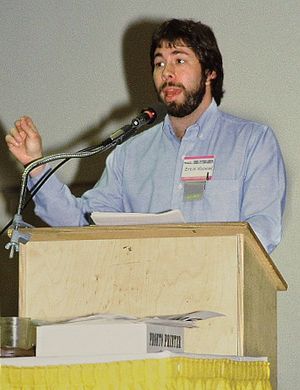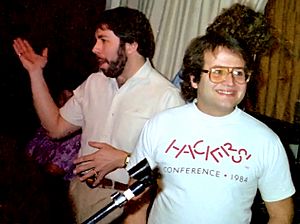Steve Wozniak facts for kids
Quick facts for kids
Steve Wozniak
|
|
|---|---|

Wozniak in 2017
|
|
| Born |
Stephen Gary Wozniak
August 11, 1950 San Jose, California, U.S.
|
| Other names |
|
| Citizenship | United States Poland Serbia |
| Education | University of Colorado Boulder (expelled) De Anza College (attended) University of California, Berkeley (BSE) |
| Occupation |
|
| Years active | 1971–present |
| Known for |
|
| Spouse(s) |
Alice Robertson
(m. 1976; div. 1980)Candice Clark
(m. 1981; div. 1987)Suzanne Mulkern
(m. 1990; div. 2004)Janet Hill
(m. 2008) |
| Children | 3 |
| Call sign | ex-WA6BND (ex-WV6VLY) |
Stephen Gary Wozniak (born August 11, 1950), known as "Woz", is an American engineer, programmer, and inventor. In 1976, he helped start Apple Computer with his friend Steve Jobs. He is famous for being a key person in the personal computer revolution.
Even though he stepped down from his main role in 1985, Wozniak still works for Apple in a special role today.
Contents
- Early Life & Education
- Before Apple: Early Inventions
- Starting Apple & Early Success
- Plane Crash & Time Away from Apple
- Returning to Apple & Leaving Again
- Life After Apple
- Wozniak's Inventions
- Giving Back: Philanthropy
- Awards and Recognition
- Wozniak's Thoughts on AI
- Personal Life
- Interesting Facts About Steve Wozniak
- Steve Wozniak Quotes
- See also
Early Life & Education
Stephen Gary Wozniak was born on August 11, 1950, in San Jose, California. His father was an engineer. Wozniak finished Homestead High School in 1968. He has a brother, Mark, and a sister, Leslie, who helps young people in San Francisco.
Wozniak briefly attended the University of Colorado Boulder. He later went to De Anza College before transferring to the University of California, Berkeley.
Before Apple: Early Inventions
In 1971, Wozniak designed and built his first computer with his friend Bill Fernandez. They called it "Cream Soda." This project helped him prepare for his later work on the Apple I and Apple II computers. Before Apple, he worked at Hewlett-Packard (HP), where he designed calculators.
Wozniak met Steve Jobs through Bill Fernandez in 1971. They became good friends.
The Blue Box Business

Wozniak and Jobs started their first business together. Wozniak read about "blue boxes," which were devices that could make free long-distance phone calls. He built his own. Jobs helped sell about 200 of these blue boxes. Jobs later said that without these blue boxes, Apple might not have started.
In 1975, Wozniak began designing the computer that would become famous: the Apple I.
Starting Apple & Early Success
By March 1976, Wozniak finished the design for the Apple I computer. He designed all the parts and the operating system himself. He tried to offer his design to HP, but they said no. Jobs then suggested they start their own company to sell the computer parts. To get money, Wozniak sold his HP calculator, and Jobs sold his Volkswagen van.
On April 1, 1976, Jobs and Wozniak officially formed the Apple Computer Company. They chose the name "Apple" after Jobs visited an apple orchard.
The Apple I Computer
Jobs and Wozniak showed the Apple I to the Homebrew Computer Club. A computer shop owner, Paul Terrell, was impressed. He ordered 50 Apple I computers, but only if they came fully built. Wozniak and Jobs assembled the first computers in Jobs's parents' home. They sold their first 50 computers to Terrell.
In November 1976, Mike Markkula invested a lot of money in Apple. Wozniak then left his job at HP to work full-time at Apple as the vice president of research and development. The Apple I was a simple computer for hobbyists. About 200 Apple I computers were made in total.
The Apple II: A Colorful Revolution

After the Apple I, Wozniak designed the Apple II. This was the first personal computer that could show color graphics. It also had the BASIC programming language built in. Wozniak found a clever way to add colors to the display.
Wozniak wanted the Apple II to have eight expansion slots, while Jobs wanted only two. After a big discussion, they agreed on eight slots. Jobs and Wozniak showed the Apple II at a computer fair in April 1977. The Apple II became one of the first very successful personal computers sold to many people around the world.
Wozniak also designed the Disk II floppy disk drive in 1978. This made it much faster to save and load computer programs than using cassette tapes.
In 1980, Apple became a public company, which made Jobs and Wozniak millionaires.
The Macintosh Influence

Wozniak had a big impact on the early design of the original Macintosh computer. This computer was special because it was the first widely produced personal computer with a graphical user interface (GUI) and a mouse. The Macintosh also helped start the desktop publishing industry with the Apple LaserWriter, which was the first laser printer to use vector graphics.
Plane Crash & Time Away from Apple
On February 7, 1981, Wozniak was flying his small plane when it crashed shortly after takeoff. He and his three passengers were injured. Wozniak had serious face and head injuries. For five weeks, he could not create new memories. He did not remember the crash or even his own name for a while. He later said that playing Apple II computer games helped him get his memory back.
Wozniak did not go back to Apple right away after he recovered.
Returning to Apple & Leaving Again
In 1981, after recovering from the crash, Wozniak went back to University of California, Berkeley to finish his engineering degree. He completed it in 1986.
In 1982, Wozniak returned to Apple to work on new products. He just wanted to be an engineer and help motivate the team.
By early 1985, Wozniak decided to leave Apple again. He felt the company was going in the wrong direction. He enjoyed engineering more than managing. He sold most of his Apple stock.
Life After Apple
After leaving Apple, Wozniak started a company called CL 9 in 1985. This company created the first programmable universal remote control, called the "CORE," in 1987.
Wozniak had always wanted to teach elementary school. He eventually taught computer classes to children from fifth to ninth grade, and also to teachers.
In 2001, Wozniak started Wheels of Zeus (WOZ). This company aimed to create wireless GPS technology to help people find everyday things easily. In 2006, Wheels of Zeus closed.
Wozniak has continued to be involved in many technology companies and projects. He co-founded Silicon Valley Comic Con (SVCC), a big pop culture and technology event, with Marvel legend Stan Lee in 2015.
In 2017, Wozniak founded Woz U, an online school for technology.
Even though he left Apple as an active employee in 1985, Wozniak has stayed on Apple's official employee list. He still represents the company at events and in interviews. He also owns Apple stock.
In 2020, Wozniak launched Efforce, a company that helps fund projects that are good for the environment. In 2021, he started Privateer Space to help deal with space debris.
Wozniak's Inventions
Wozniak is listed as the inventor on several important Apple patents, including:
- US Patent No. 4,136,359: "Microcomputer for use with video display" (This led to his induction into the National Inventors Hall of Fame.)
- US Patent No. 4,210,959: "Controller for magnetic disc, recorder, or the like"
- US Patent No. 4,217,604: "Apparatus for digitally controlling PAL color display"
Giving Back: Philanthropy
In 1990, Wozniak helped start the Electronic Frontier Foundation, which works to protect digital rights. He is also a founding sponsor of the Tech Museum, the Silicon Valley Ballet, and the Children's Discovery Museum of San Jose.
Since leaving Apple, Wozniak has given money and technical help to the technology program in his local school district in Los Gatos. He also formed an organization called Un.U.Son. (Unite Us In Song) to support his educational and charity projects.
Awards and Recognition
Steve Wozniak has received many awards for his achievements:
- In 1985, he and Steve Jobs received the National Medal of Technology from US President Ronald Reagan. This is a very high honor for technological progress.
- In 1998, he was named a Fellow of the Computer History Museum for co-founding Apple and inventing the Apple I.
- In September 2000, Wozniak was inducted into the National Inventors Hall of Fame.
- He received the Isaac Asimov Science Award in 2011.
- In 2014, he received the Hoover Medal, an award for engineers who help humankind.
- In 2015, the city of San Jose named a street "Woz Way" in his honor. The Children's Discovery Museum of San Jose is located at 180 Woz Way.
- He was also named the 2015 Alumnus of the Year by the University of California, Berkeley's Alumni Association.
- In 2016, High Point University announced that Wozniak would be their Innovator in Residence, connecting with students.
- In 2021, he received the IEEE Masaru Ibuka Consumer Electronics Award for his pioneering work in designing user-friendly personal computers.
Honorary Degrees
Wozniak has received many honorary doctoral degrees from universities, including:
- University of Colorado Boulder: 1989
- North Carolina State University: 2004
- Michigan State University: 2011
- Concordia University in Montreal, Canada: 2011
- Santa Clara University: 2012
Wozniak's Thoughts on AI
Wozniak has shared his thoughts on artificial intelligence (AI). He is not worried about super-intelligent computers taking over. He believes computers will always be partners with humans because human "intuition" is unique.
Personal Life

Wozniak lives in Los Gatos, California. He has three children. His current wife is Janet Hill.
In 2006, he wrote his autobiography, iWoz: From Computer Geek to Cult Icon: How I Invented the Personal Computer, Co-Founded Apple, and Had Fun Doing It. The book became a New York Times Best Seller.
Wozniak has often said he does not care much about having a lot of money. When Apple first became public in 1980, he offered $10 million of his own stock to early Apple employees.
In November 2023, Wozniak had a minor stroke but recovered quickly.
Interesting Facts About Steve Wozniak
- His birth certificate says "Stephan," but he uses "Stephen."
- He is often called "Woz," "The Woz," or "The Wonderful Wizard of Woz."
- In the early 1970s, his blue box designs earned him the nickname "Berkeley Blue."
- Wozniak says watching Star Trek inspired him to start Apple.
- The Apple I sold for $666.66. Wozniak chose the price because he liked "repeating digits" and did not know about its other meaning.
- On his diploma from Berkeley, his name is "Rocky Raccoon Clark." He used a fake name to avoid attention.
- Wozniak became a citizen of Serbia in December 2023.
- He is a big fan of the NHL team San Jose Sharks.
- Wozniak has face blindness, which means he has trouble recognizing faces.
Steve Wozniak Quotes
- "If you love what you do and are willing to do what it takes, it's within your reach."
- "The easier it is to do something, the harder it is to change the way you do it."
- "To give of yourself is much more important than giving a gift you can buy."
- "Wherever smart people work, doors are unlocked."
- "Imagination is something you do alone."
See also
 In Spanish: Steve Wozniak para niños
In Spanish: Steve Wozniak para niños









